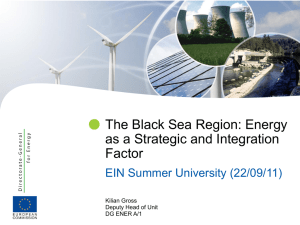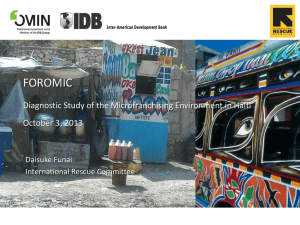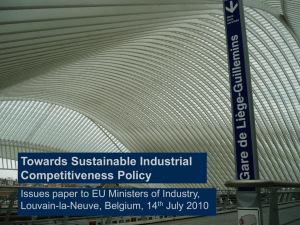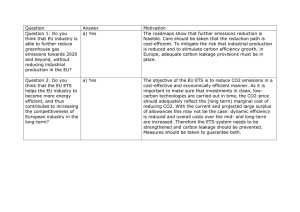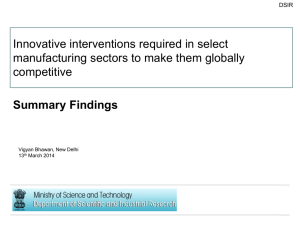Towards Industrial Policy
advertisement
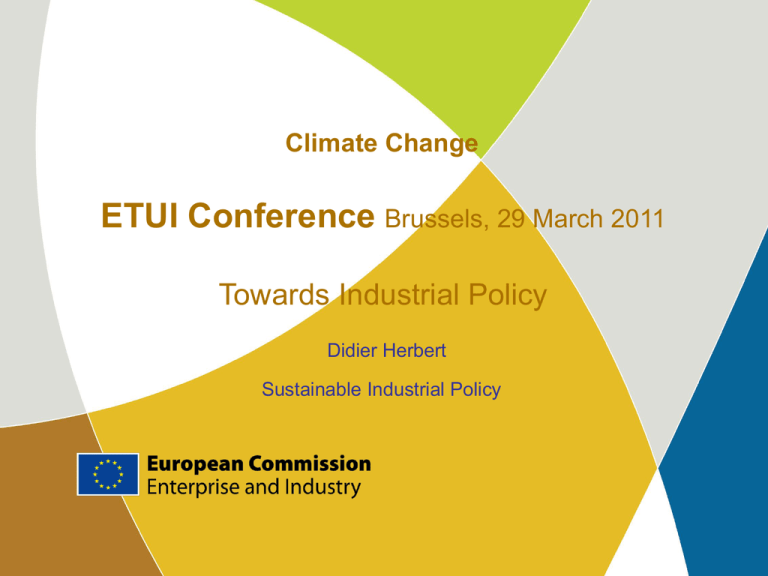
Climate Change ETUI Conference Brussels, 29 March 2011 Towards Industrial Policy Didier Herbert Sustainable Industrial Policy Europe 2020: 7 flagship initiatives underpin the targets S m a rt G row th I n n ov a tio n « Innovation Union » E d u c a tio n « Y outh on the move » D ig ita l s o c ie ty « A digital agenda for E urope » S u s ta i n a b le G row th I n c l u s iv e G row th C lim a te , E m p lo y m e n t e ne rg y a nd a n d s k ills m o b ility « An agenda for new s kills and jobs « R es ource » efficient E urope » C o m p e titiv e n e F ig h tin g ss p ov e r ty « An indus trial « E uropean policy for the platform agains t globalis ation era » poverty » I. European Industry: Some facts and figures •Manufacturing industry is an essential pillar for growth and jobs: One fifth of EU output and employment (more than 50% of private sector employment) Around 4/5 of EU R&D investments 75% of EU exports •Industry solution-provider to tackle societal challenges II. INDUSTRIAL ACTIVITY CREATES WEALTH AND JOBS... BUT ALSO HAS UNDESIRABLE EFFECTS… Natural resource depletion Climate change Pollution of air, water, soil Traffic congestion Waste Global population will grow from 6bn to 9bn and they aspire to OECD levels of income • EU’s CO2 reduction targets – -20-30% by 2020 – >-80% by 2050 III. Competitiveness in the face of climate change: Questions •Is there a contradiction between competitiveness and climate change policy (20/20/20 package)? •Does the promotion of sustainability lead to burdens for EU industry’s competitiveness? Competitiveness in the face of climate change: Some preliminary answers •EU industry is quite energy efficient compared to other countries and is decoupling growth and pollution. •Industry (directly and indirectly) emits only 25% of total CO2 emissions in EU •Abatement potential for consumers or in transport can be cheaper than in industry GHG Target: -20% compared to 1990 -14% compared to 2005 EU ETS -21% compared to 2005 Non ETS sectors -10% compared to 2005 27 Member State targets, stretching from -20% to +20% How can we reconcile ambitious climate change objectives with industrial competitiveness ? When global action is not yet certain … The Challenge… CLIMATE COMPETITIVENESS SOCIAL •Some sectors are particularly vulnerable •These industries demand special measures •Risk of Carbon Leakage •All options not Cost Free ETS - Harmonised allocation rules as of 2013 •Auctioning is default allocation method ●Power sector: 100% as of 2013 (save limited exemptions for 10 new MS as per Art 10c) •Transitional free allocation based on BMs Sectors ‘not at risk of carbon leakage’ ●Phasing out free allocation (80% of BM in 2013 – 30% of BM in 2020 – 0% in 2027) Sectors at risk of ‘carbon leakage’ ●Free allowances , limited to 100% of Benchmarks II.2 An example of a challenge? Cement • 1 ton Cement = 0,8 ton CO2 • Avg price cement = €60/ton • ton CO2=12 Euro • Risk of greater imports/less exports on third markets • “Carbon leakage” CO2 emissions for relevant sectors in the carbon leakage assessment (bubble size indicates size of sector's emissions) - Sectors in bold do not reach the CL criteria - 60% Organic chemicals 50% Paper and Paperboard Aluminium Plastics (QL) Iron and steel 40% Ceramic tiles Fertilizers Trade intensity Bricks 30% Coke oven products Industrial gases Casting of iron (QL) 20% Petroleum Flat glass Cement Casting of light metals (QL) 10% Casting of steel (QL) Lime 0% -10.0% 10.0% 30.0% 50.0% -10% CO2 Total costs 70.0% 90.0% QL = Sectors currently under Qualitative assessment 110.0% Illustration of a BM curve Emission Intensity (kg CO2/t product) Purchased allowances Benchmark Free allowances 10% best-sample Nb of installations How to help industry meeti,ng challenge ? Use industrial policy tools, Ex: SILC Analysis & Screening Candidate sectors SHORT-TERM Development & implementation of innovation projects MID-/LONG-TERM Scale-up & demonstration projects SILC I : SHORT-TERM innovation measures Purchased allowances Free allowances Benchmark line Several initiatives foreseen • Bring together relevant technology platforms to ensure appropriate R&D, financing and deployment strategies for low-carbon production • Promote demonstration projects and uptake for ultra-low carbon production technologies (including CCS) • Explore opportunities to bring in further innovative incentive mechanisms linked to the carbon market (namely fast movers) Many EU actions contribute to sustainable competi Innovat ion R& D Climate Change Cohesio n Knowledge Skills ICT Infrastru ctures Employ ment Regio nal Internatio nal Policy Dimensio n Sustainable competitiveness Trade CSR Competi tion Internal Market Energy Fiscal barrie rs Sustaina ble Develop ment Marke t Acces s Markets by themselves will not deliver all the needed solutions… •Clear Policy Signals are essential – Certainty, Coherence •Need governments, industry and social partners support: Standards and regulation – implementation crucial Delivering green skills Supporting environmental technologies •Share best practice, learn from each other, stakeholder consultation e.g. sustainable industry forum/workshops; industry/private sector engagement But…Can Europe combine ambitious climate change objectives with strong industrial competitiveness… Importance of global commitments and action ACTION PLAN ON SUSTAINABLE INDUSTRIAL POLICY and SUSTAINABLE CONSUMPTION & PRODUCTION… Example : Sustainable Product Policy Driving the energy and environmental performance of products upwards through ECODESIGN Creating a critical mass of demand through LABELLING and INCENTIVES for the best performing products Recast Dec 2009 extended to energy-related products; Review by 2012 Energy savings of 12% by 2020 from measures already adopted Global approach for global issue Ensuring a level playing field for Energy Intensive Industries e.g. ETS Benchmarks and encouraging development of Sectoral Approaches Retail Forum & Food SCP Roundtable Green supply chains; Share best practice; Wide stakeholder participation; Promote sustainable products; Reduce environmental footprint of retail sector ++ e.g. Green Public Procurement (16% of economy), Verbesserungspotential der verabschiedeten Maßnahmen Enterprise and Industry Directorate-General Sustainable Industrial Policy Ökodesign-Verordnung Annahme 1275/2008 17.12.2008 Einsparpotential (jährlich bis 2020) 35 TWh 04.02.2009 18.03.2009 6 TWh 37 TWh 18.03.2009 06.04.2009 22.07.2009 22.07.2009 22.07.2009 22.07.2009 38 TWh 9 TWh 135 TWh 25 TWh 26 TWh 4 TWh 107/2009 244/2009 245/2009 278/2009 640/2009 641/2009 642/2009 643/2009 Stromverluste im Bereitschaftsund Ruhezustand von Haushaltsund Bürogeräten Einfache Set-Top-Boxen Haushaltslampen mit ungebündeltem Licht Straßen- und Bürobeleuchtung Externe Netzteile Industriemotoren Heizungsumwälzpumpen Fernsehgeräte Haushaltskühl- und Gefriergeräte 315 TWh Das geschätzte jährliche Einsparungspotential in 2020 entspricht 12% des Stromverbrauchs in Europa in 2007 Environmental goods and services - the window of opportunity… • New markets, in Europe and internationally, • Lead these markets internationally • But market shares under threat • Use trade policy – upcoming FTAs • Relationship between core and connected industries; upstream suppliers and downstream users; business models • “You are only as Green as your Supply chain” Stimulus Packages: • China >$200 bn green investments • Korea >80% green; Green New Deal $93 bn >1 m green jobs Green is always Good? The EU needs to be economically and socially as well as environmentally sustainable. Only economically successful companies developing innovative products will be able to contribute to effective environmental protection and social progress. Europe is responsible for only around 13% of global carbon emissions and it does not make economic or environmental sense to inadvertently overburden industry here and drive production to less efficient locations. The EU will only be able to fulfil its leadership role in this field if it manages to show that is indeed realistic and feasible to combine optimal levels of resource efficiency with industrial competitiveness. Net impact on number of jobs likely to be relatively limited, but many more job reallocations Wide impact on skills, job content… Need for high quality jobs Facilitating industrial change •Mainly responsibility of social partners •Consult on European framework for restructuring •Globalisation Adjustment Fund •Cohesion policy and Structural Funds •Rescue/restructuring Guidelines Flagship Initiative: "An industrial policy for the globalisation era" (ref. COM(2010) 614 of 28/10/10) …supporting the transition of manufacturing sectors to greater energy and resource efficiency …reducing the transaction costs of doing business in Europe, promoting clusters and improving affordable access to finance …promoting the restructuring of sectors in difficulty towards future oriented activities, including through quick redeployment of skills to emerging high growth sectors and markets …promoting technologies and production methods that reduce natural resource use …supporting the transition of service and manufacturing sectors to greater resource efficiency, including more effective recycling Flagship Initiative "Resource efficient Europe" in 2011 •The aim is to support the shift towards a resource efficient and low-carbon economy that is efficient in the way it uses all resources. The aim is to decouple our economic growth from resource and energy use, reduce CO2 emissions, enhance competitiveness and promote greater energy security; •Resource efficiency means doing more with less. It means managing our resources - material resources such as metals, minerals and food, and natural resources which provide services, such as clean air, land and water - sustainably, throughout their life cycle, so as to reduce the environmental impact of their use. •But need to carefully manage transition from industry perspective – not automatically win-win or cost free A cost-efficient pathway towards 2050 80% domestic reduction in 2050 is100% feasible 100% with currently available Power Sector 80% technologies, with behavioural change only induced Residential & Tertiary 60% through prices If all economic sectors Industry contribute to a varying 40% degree & pace. Current policy 60% 40% Transport Efficient pathway: -25% in 2020 -40% in 2030 -60% in 2040 80% 20% 20% Non CO2 Agriculture Non CO2 Other Sectors 0% 1990 0% 2050 26 2000 2010 2020 2030 2040 Contact: Didier Herbert European Commission Directorate-General Enterprise and Industry Sustainable Industrial Policy Tel: +32.2.29.90087 http://ec.europa.eu/enterprise/policies/sustainable-business/index_en.htm



